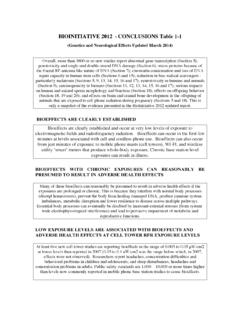Transcription of 6 & 12 Volt Battery and Systems Tester with 100 Amp Load
1 6 & 12 VoltBattery and SystemsTesterwith 100 Amp LoadForm No. 841-731 , 10:11 AM12 DESCRIPTIONThis Load Tester tests 6 or 12 volt automotive-size lead-acid batteries underload. It will also test 6 or 12 volt charging Systems and 12 volt startingsystems. This Tester comes complete with a color-coded precision meter,heavy-duty saw-tooth clamps, and a nickel-chrome plated 6 or 12 VoltCharging system 6 or 12 volt SystemsStarting system 12 volt SystemsMeter 3%Meter Scale 4 to 16 Volts DCMeter Scale , 10:11 AM23 GENERAL SAFETY INFORMATIONDO NOT ATTEMPT TO OPERATE THIS Battery Tester until readingthis entire instruction manual. It contains information necessary for the safeoperation of this EXPLOSION CAN KILL, INJURE, AND CAUSE PROPERTYDAMAGE!
2 1. ALWAYS wear safety glasses when working with a lead-acid Battery toreduce risk of Battery acid contact with NEVER create a spark or flame near a lead-acid Battery . It takes verylittle to ignite the explosive gasses produced by a lead-acid NEVER connect BOTH Tester clamps directly to a Battery or arcing mayoccur. Consult the OPERATION instructions for proper connection anddisconnection NEVER connect the Tester clamps to the wrong Battery terminals orarcing may NEVER attach the Tester clamps to a Battery with the load switchpressed or arcing will case can burn skin or cause property damage!6. ALWAYS be aware of the high heat created during load testing and theareas of the Tester case that become hot.
3 Keep hands clear of theseareas and do not allow painted or fabric surfaces to come in contactwith these , 10:11 AM34 OPERATION1. Follow these steps when Battery is installed In vehicle. Be aware that aspark near Battery may cause Battery EXPLOSION CAN KILL, INJURE, AND CAUSE PROPERTYDAMAGE! TO REDUCE RISK OF Battery EXPLOSION, READ THEFOLLOWING OPERATING INSTRUCTIONS AND THE PREVIOUSSAFETY INSTRUCTIONS PRIOR TO OPERATING THIS Position cords to reduce risk of damage by hood, door or movingengine Stay clear of fan blades, belts, pulleys, and other moving parts thatcan cause injury to Check polarity of Battery posts: POSITIVE (POS, P, +) Battery postusually has a larger diameter than NEGATIVE (NEG, N, ) Determine which post of the Battery is grounded (connected) to thechassis.
4 If negative post is grounded (as in most vehicles), see iteme. If positive post is grounded to the chassis, see item For negative-grounded vehicle, connect POSITIVE (red) clip frombattery Tester to POSITIVE (POS, P, +) ungrounded post of NEGATIVE (black) clip to vehicle chassis or engine blockaway from the Battery . Do not connect clip to carburetor, fuel linesor sheetmetal body parts. Connect to a heavy gauge metal part ofthe frame or engine positive grounded vehicle, connect NEGATIVE (black) clip toNEGATIVE (NEG, N, ) ungrounded post of Battery . ConnectPOSITIVE (red) clip to vehicle chassis or engine block away fromthe Battery . Do not connect clip to carburetor, fuel lines, or sheetmetal body parts.
5 Connect to a heavy gauge metal part of the frameor engine When disconnecting, remove clip from vehicle chassis FIRST, thenremove the clip from the Battery Follow these steps when Battery is outside vehicle. Be aware that aspark near Battery may cause Battery EXPLOSION CAN KILL, INJURE, AND CAUSE PROPERTYDAMAGE! TO REDUCE RISK OF Battery EXPLOSION, READ THEFOLLOWING OPERATING INSTRUCTIONS AND THE PREVIOUSSAFETY INSTRUCTIONS PRIOR TO OPERATING THIS Check polarity of Battery posts: POSITIVE (POS, P, +) Battery postusually has a larger diameter than NEGATIVE (NEG, N, ) Attach a 24" long, 6 gauge (AWG) insulated Battery cable toNEGATIVE (NEG, N, ) Battery , 10:11 AM45c.
6 Connect POSITIVE (red) clip to POSITIVE (POS, P, +) post Position yourself and free end of cable as far away from Battery aspossible. Then connect the NEGATIVE (black) clip to the free end ofthe Do not face Battery when making final )When disconnecting, always do so in reverse sequence ofconnecting procedure and break the first connection while as faraway from Battery as TESTING BATTERIES (CONVENTIONAL ANDMAINTENANCE-FREE, LEAD-ACID, AUTOMOTIVE TYPES)CAUTIONHOT CASE CAN BURN SKIN OR CAUSE PROPERTY DAMAGE! Theload applied by this Tester generates high heat. Be aware that the frontand back surfaces of the case, above the meter and below the handle,can become hot. Keep skin clear from these areas.
7 Also, do not lay hottester on painted or fabric 12 volt Batteries - Start 6 volt Batteries - Go to Step # Determine approximate rating of the Battery in Cold Cranking Amps(CCA).2. When batteries are cold, they perform less efficiently. This will causetest readings to be lower than the true performance of the Battery . Fortesting cold batteries derate the Battery as follows: For temperaturesbetween 30 and 10 degrees F, read the scale as if the Battery were 50 CCA smaller. For temperatures between +10 and -10 degrees F, readthe scale as if the Battery were 100 CCA smaller. For lowertemperatures, read the scale as if the Battery were 150 CCA double checking to make sure all connections are correct andtight, press the load switch on the bottom of the Tester for 10 read the meter scale for the voltage of Battery being tested.
8 Referto the following to determine Battery prevent overheating, press the load switch for 10 seconds at most,then allow Tester to cool for 5 minutes before pressing the load switchagain if further testing is Green (Good)Note:When testing a 12 volt Battery , the needle must be in the greenarea at the step that equals the Battery s Cold Cranking Amp(CCA) rating to be considered Good . Battery capacity is OK. Battery may or may not be fully Battery PERCENT OF CHARGE TEST (see end of thismanual). If less than a full charge, check for electrical system drain , 10:11 AM56possible charging system problems. Recharge Battery to full chargebefore returning to Yellow (weak) or Red (bad) and Needle Stays in One Place: Batterycapacity is not satisfactory.
9 Battery may be defective or just needrecharging. Check specific gravity of Battery , or perform BATTERYPERCENT OF CHARGE TEST to determine state of charge. If state ofcharge is low, recharge Battery and retest. If Battery is fully charged andstill tests weak or bad, replace Battery . If Battery will not accept a fullcharge, replace Yellow or Red (Weak or Bad) and Needle drops during test: Batterymay be defective or very discharged. Release load switch and watchmeter. If meter returns to 12 volts or above within several seconds, thebattery is probably defective. A slow return of the needle to 12 volts orabove indicates that the Battery is run down and has little charge. Checkspecific gravity, or perform Battery PERCENT OF CHARGE TEST,recharge if necessary, and STARTING system (12 volt ONLY)1.
10 Test Battery as indicated above. If Battery is not good, do not performthis test. Replace Battery , then test starting system . When doing thebattery test, read the exact voltage that the Battery has under Ioad. Ifthe voltage does not settle in after 10 seconds, the starting test cannotbe )tseTdaoLyrettaBmorF( Using the voltage obtained in the Battery test, refer to the following chart(also at the bottom of the meter face) to determine the minimumcranking voltage that should be present during starting. For vehicleswith engines larger than 200 cubic inch displacement ( liters), find theLoad Volts that you obtained when doing the load test in step #1. Thengo directly across to find your vehicle s Minimum Cranking Voltage.






